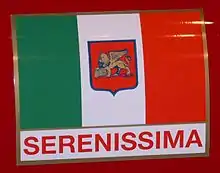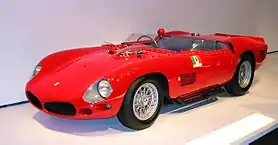Scuderia Serenissima
Scuderia Serenissima and Scuderia SSS Republica di Venezia were names used by Giovanni Volpi to enter his own cars in Formula One and sports car racing in the early 1960s.
 | |
| Full name | Scuderia Serenissima Scuderia SSS Republica di Venezia |
|---|---|
| Base | Italy |
| Founder(s) | Giovanni Volpi |
| Noted drivers | |
| Formula One World Championship career | |
| First entry | 1961 Monaco Grand Prix |
| Races entered | 8 [1][2] |
| Drivers' Championships | 0 |
| Race victories | 0 |
| Pole positions | 0 |
| Fastest laps | 0 |
| Final entry | 1962 Italian Grand Prix |

Scuderia Serenissima was an auto racing team in the early 1960s. Funded by Giovanni Volpi, Serenissima used Ferraris to much success until the founder financed the exiled Ferrari company, ATS. Thereafter, Enzo Ferrari would no longer sell his cars to Serenissima, so the company turned to De Tomaso, ATS, and Maserati. Volpi, and thus Serenissima, halted automobile operations in 1970.
Formula One
In 1961, Scuderia Serenissima entered the Formula One World Championship. They first entered a Cooper T51 for Maurice Trintignant at the 1961 Monaco Grand Prix, where he finished seventh. In Belgium, Trintignant retired on lap 23 with a broken gearbox after having qualified his car in 19th place. At the 1961 French Grand Prix, Scuderia Serenissima entered two cars. Again the Cooper for Trintignant and a De Tomaso for Giorgio Scarlatti. Trintignant finished in 13th place while Scarlatti retired on lap 15 when his engine broke down. At the German Grand Prix Trintignant retired on lap 12 when his engine broke down. In the 1961 Italian Grand Prix, Scuderia Serenissima again entered two cars, the Cooper for Trintignant and a De Tomaso for Nino Vaccarella. Trintignant finished the race in ninth place and Vaccarella retired on lap 13 when his engine broke down. In 1962, now called Scuderia SSS Republica di Venezia, they entered cars for Nino Vaccarella. In Monaco, Vaccarella failed to qualify for the race. Three races later in Germany, Vaccarella finished in 15th place. At the last race for the Scuderia in Italy Vaccarella finished in 9th place. In 1966 Serenissima supplied engines to McLaren. And at the 1966 British Grand Prix Bruce McLaren finished in sixth place, scoring one World Championship point.
Sports car racing
In 1963, Volpi began developing his own prototype GT car, the Jungla GT. It used a new V8 engine, designed by Alberto Massimino, with closed bodywork by Francesco Salomone (built by Gran Sport). A later open version was built by Fantuzzi.
Complete Formula One World Championship results
(key)
| Year | Chassis | Engine | Tyres | Driver/s | 1 | 2 | 3 | 4 | 5 | 6 | 7 | 8 | 9 |
|---|---|---|---|---|---|---|---|---|---|---|---|---|---|
| 1961 | Cooper T51 De Tomaso F1 |
Maserati 6-1500 1.5 L4 OSCA 372 1.5 L4 Alfa Romeo Giulietta 1.5 L4 |
D | MON | NED | BEL | FRA | GBR | GER | ITA | USA | ||
| 7 | Ret | 13 | Ret | 9 | |||||||||
| Ret | |||||||||||||
| Ret | |||||||||||||
| 1962 | Lotus 18/21 24 Porsche 718 |
Climax FPF 1.5 L4 Porsche 547/3 1.5 F4 |
D | NED | MON | BEL | FRA | GBR | GER | ITA | USA | RSA | |
| DNQ | 15 | 9 | |||||||||||
Source:[3] | |||||||||||||
As an engine supplier
(key)
| Year | Entrant | Chassis | Engine | Tyres | Drivers | 1 | 2 | 3 | 4 | 5 | 6 | 7 | 8 | 9 | WCC | Points |
|---|---|---|---|---|---|---|---|---|---|---|---|---|---|---|---|---|
| 1966 | Bruce McLaren Motor Racing | McLaren M2B | Serenissima M166 3.0 V8 | F | MON | BEL | FRA | GBR | NED | GER | ITA | USA | MEX | 12th | 1 | |
| DNS | 6 | DNS | ||||||||||||||
Source:[4] | ||||||||||||||||
References
- "Scuderia Serenissima results at chicanef1.com". Formula One Results. Retrieved 31 January 2012.
- "Scuderia SSS Republica di Venezia results at chicanef1.com". Formula One Results. Retrieved 31 January 2012.
- Small, Steve (1994). The Guinness Complete Grand Prix Who's Who. Guinness. pp. 334, 384 and 386. ISBN 0851127029.
- Small, Steve (1994). The Guinness Complete Grand Prix Who's Who. Guinness. p. 236. ISBN 0851127029.